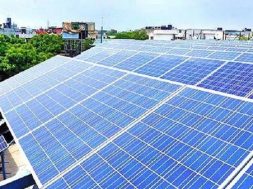
U.S. Solar Module Manufacturing Surpasses 50 GW, Marking a Major Clean Energy Milestone – EQ
In Short : The Solar Energy Industries Association (SEIA) announced that the U.S. has surpassed 50 GW in annual solar module manufacturing capacity. This milestone reflects the nation’s growing commitment to domestic solar production, driven by policy support and increasing demand for clean energy. The expansion is expected to strengthen energy security and reduce reliance on imports.
In Detail : The Solar Energy Industries Association (SEIA) has reported that the United States has surpassed 50 GW in annual solar module manufacturing capacity. This milestone highlights the rapid expansion of the country’s solar industry, driven by supportive policies and increasing demand for clean energy solutions. The growth in domestic manufacturing is expected to play a crucial role in strengthening the nation’s renewable energy infrastructure.
The increase in production capacity is largely attributed to federal incentives, including tax credits and subsidies aimed at boosting local solar manufacturing. With rising concerns over energy security and supply chain resilience, the U.S. government has been actively encouraging domestic production to reduce dependence on imports. This shift is expected to create more jobs and enhance technological advancements in the sector.
Industry experts believe that achieving 50 GW capacity will significantly impact the solar market, enabling greater deployment of solar energy across the country. As more utility-scale and residential solar projects come online, the enhanced production capacity will help meet growing energy demands while ensuring affordability and reliability. The expansion also aligns with the U.S. commitment to reducing carbon emissions and achieving its climate goals.
The surge in solar manufacturing has also been supported by private sector investments and increased collaboration between energy companies and technology providers. Several manufacturers have ramped up their operations, investing in advanced production techniques to improve efficiency and reduce costs. This momentum is expected to further accelerate the transition toward a cleaner energy mix.
Despite the progress, challenges remain, including supply chain constraints and competition from global manufacturers. Ensuring a stable supply of raw materials and maintaining cost competitiveness will be critical for sustaining growth. Policymakers and industry leaders are working together to address these challenges and enhance the overall competitiveness of U.S. solar manufacturing.
The achievement of surpassing 50 GW in annual module production marks a significant step toward energy independence and sustainability. With continued policy support and technological advancements, the U.S. solar industry is well-positioned for further growth, contributing to the country’s long-term renewable energy goals.













